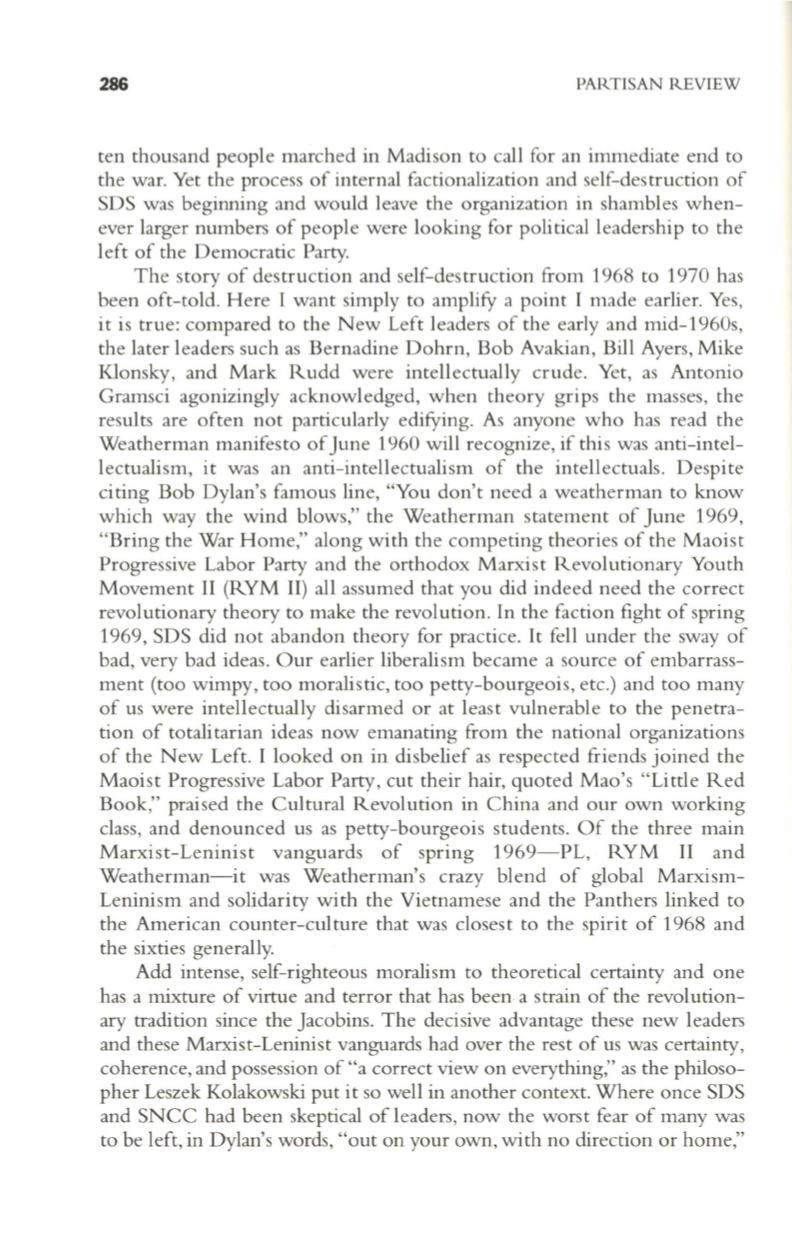
286
PARTISAN REVIEW
ten thousand people marched in Madison to call for an immediate end
to
the war. Yet the process of internal factionalization and self-destruction of
SDS was beginning and would leave the organization in shambles when–
ever larger numbers of people were looking for political leadership to the
left of the Democratic Party.
The story of destruction and self-destruction from 1968 to 1970 has
been oft-told. Here I want simply to amplify a point I made earlier. Yes,
it is true: compared to the New Left leaders of the early and rnid-1960s,
the later leaders such as Bernadine Dohrn, Bob Avakian, Bill Ayers, Mike
Klonsky, and Mark Rudd were intellectually crude. Yet, as Antonio
Gramsci agonizingly acknowledged, when theory grips the masses, the
results are often not particularly edifying. As anyone who has read the
Weatherman manifesto ofJune 1960 will recognize, if this was anti-intel–
lectualism, it was an anti-intellectualism of the intellectuals. Despite
citing Bob Dylan's famous line, "You don't need a weatherman to know
which way the wind blows," the Weatherman statement of June 1969,
"Bring the War Home," along with the competing theories of the Maoist
Progressive Labor Party and the orthodox Marxist Revolutionary Youth
Movement II (RYM II) all assumed that you did indeed need the correct
revolutionary theory to make the revolution. In the faction fight of spring
1969, SDS did not abandon theory for practice.
It
fell under the sway of
bad, very bad ideas. Our earlier liberalism became a source of embarrass–
ment (too wimpy, too moralistic, too petty-bourgeois, etc.) and too many
of us were intellectually disarmed or at least vulnerable to the penetra–
tion of totali tarian ideas now emanating from the national organizations
of the New Left. I looked on in disbelief as respected friends joined the
Maoist Progressive Labor Party, cut their hair, quoted Mao's "Little Red
Book," praised the Cultural Revolution in China and our own working
class, and denounced us as petty-bourgeois students. Of the three main
Marxist-Leninist vanguards of spring 1969-PL, RYM II and
Weatherman-it was Weatherman's crazy blend of global Marxism–
Leninism and solidarity with the Vietnamese and the Panthers linked to
the American counter-culture that was closest to the spirit of 1968 and
the sixties generally.
Add intense, self-righteous moralism to theoretical certainty and one
has a mixture of virtue and terror that has been a strain of the revolution–
ary tradition since the Jacobins. The decisive advantage these new leaders
and these Marxist-Leninist vanguards had over the rest of us was certainty,
coherence, and possession of "a correct view on everything," as the philoso–
pher Leszek Kolakowski put it so well in another context. Where once SDS
and SNCC had been skeptical of leaders, now the worst fear of many was
to be left, in Dylan's words, "out on your own, with no direction or home,"


